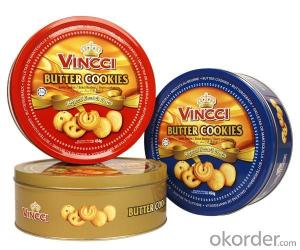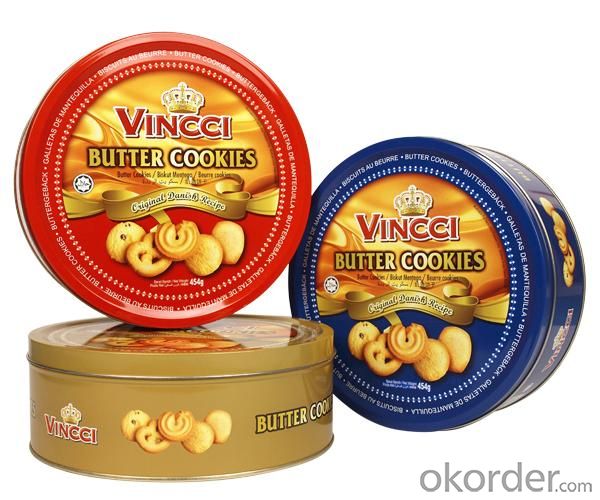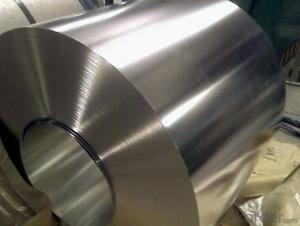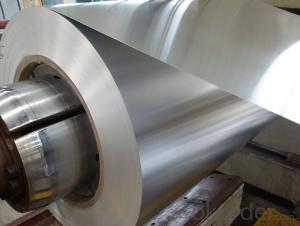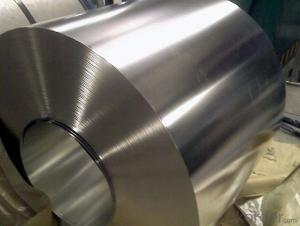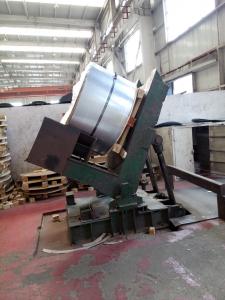Tinplate For Cookie Can, EN 10202, Printed Tinplate
- Loading Port:
- Tianjin
- Payment Terms:
- TT OR LC
- Min Order Qty:
- 25 m.t.
- Supply Capability:
- 30000 m.t./month
OKorder Service Pledge
OKorder Financial Service
You Might Also Like
1.Usage
Tinplate is widely used for making all types of containers, containing industrial usage such as paint can, oil can, aerosol cans etc., and food cans like milk powder cans, tomato paste can, dry food cans etc.
2. Quality
As a state owned company and a large tinplate supplier in China, our tinplate quality ranks 1st level in China, similar to Bao Steel, Posco etc.
3. Specification
standard: GB/T2520, JIS G3303, DIN EN10202
Material: MR /SPCC
Thickness available: 0.16-0.50MM
Width available: 600~1050MM
Temper grade: T1 – DR8
Tin coating: ordinary 2.8g/2.8g, 5.6g/5.6g and others
Package: sea worthy export package.
Applications: Tin can for chemicals & paint cans, industrial cans, food cans
4. Our factory photo & equipments

5. Our Markets:
now our tinplate has been sold to more than 50 countries, including Europe country, Gulf Area, South American, South Afric etc.
6. Our Overseas Wareouses:
Furthermore, in the year 2014, we have more than 10 overseas warehouses all over the word, located in KSA, UAE, Oman, Russia, Kuwait, Qatar, Oman, Chile, Brazil etc.
7. FAQ
a. what's the annual output?
about 500,000 tons per year.
b. where's the raw matrial from?
our hot rolled coil is purchased from Capital Steel and other state owned mill, with quite good quality.
c. how long is the delivery time?
normally for SPCC about 45~55 days, while 65~75 days for MR material
d. how to control the quality during production process?
inside our workshop, we have MES syestem. It realizes the optimization of the production procedure in the workshop. It could record each step of the whole production procedures, and if some problem appears, factory could easily found and take action, it’s quite helpful to monitor and control the quality.
- Q: What are the main applications of tinplate?
- The main applications of tinplate include food and beverage packaging, aerosol cans, electrical components, and decorative items.
- Q: What material is the tin plate, please?
- Popularly speaking, it was tin plated on the surface of the iron sheet, just because it was imported by Macao at that time, so it always called "tinplate iron"
- Q: What are the main challenges in tinplate warehousing?
- The main challenges in tinplate warehousing include ensuring proper inventory management, maintaining product quality and integrity, optimizing space utilization, managing complex logistics, and adhering to stringent safety and regulatory requirements.
- Q: What are the common misconceptions about tinplate packaging?
- One common misconception about tinplate packaging is that it is not environmentally friendly. While tinplate is made from steel, which is a finite resource, it is highly recyclable and can be reused multiple times without losing its quality. Additionally, tinplate packaging has a long shelf life, reducing the need for frequent replacement. Another misconception is that tinplate packaging is easily damaged or dented. However, modern manufacturing techniques have made tinplate packaging highly durable and resistant to external pressures, ensuring the protection of the products inside.
- Q: What are the main applications of tinplate in the marine industry?
- Tinplate is commonly used in the marine industry for various applications such as manufacturing of cans for food and beverages, corrosion-resistant coatings for ship components, and protective packaging for marine equipment and supplies. Additionally, tinplate is also used for decorative purposes, such as in the production of marine-themed items and accessories.
- Q: Can tinplate be customized with embossing or debossing?
- Yes, tinplate can be customized with embossing or debossing techniques.
- Q: What are the different printing techniques used on tinplate?
- There are several different printing techniques used on tinplate, including lithography, screen printing, and offset printing. Lithography involves creating an image on a flat surface, such as a metal plate, and then transferring that image onto the tinplate. Screen printing involves using a mesh screen to apply ink onto the tinplate in a desired pattern or design. Offset printing involves transferring an image from a plate onto a rubber blanket, and then onto the tinplate. Each technique has its own advantages and is chosen based on factors such as cost, complexity of the design, and desired quality of the print.
- Q: Cookies with tinplate packaging has what advantage?
- Good mechanical properties: tinplate cans relative to other containers, such as plastic, glass, paper containers and strength, and good rigidity, it is not easy to break. It is not only used for small sale packing, but also the main container for large transportation package.
- Q: Can tinplate be used for outdoor applications?
- Yes, tinplate can be used for outdoor applications. Tinplate is a popular material for outdoor use due to its corrosion resistance and durability. It is commonly used in outdoor products such as cans, containers, and packaging for various purposes.
- Q: How does tinplate packaging contribute to product protection against oxidation?
- Tinplate packaging contributes to product protection against oxidation due to its inherent properties. Tin is a highly corrosion-resistant material that acts as a barrier against external factors such as moisture, air, and light, which are known to accelerate oxidation processes. The tin coating on the tinplate acts as a protective layer, preventing direct contact between the product and the surrounding environment, thus reducing the risk of oxidation. This helps to extend the shelf life of products, maintain their quality, and preserve their flavor and nutritional value.
Send your message to us
Tinplate For Cookie Can, EN 10202, Printed Tinplate
- Loading Port:
- Tianjin
- Payment Terms:
- TT OR LC
- Min Order Qty:
- 25 m.t.
- Supply Capability:
- 30000 m.t./month
OKorder Service Pledge
OKorder Financial Service
Similar products
Hot products
Hot Searches
Related keywords
